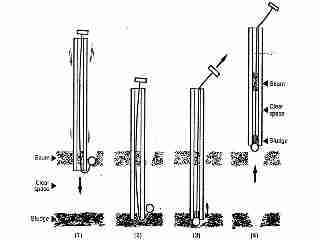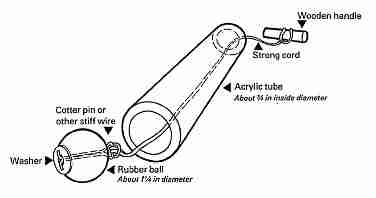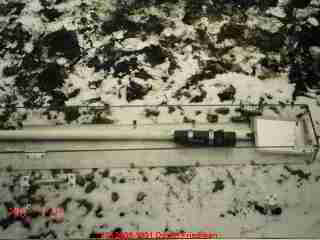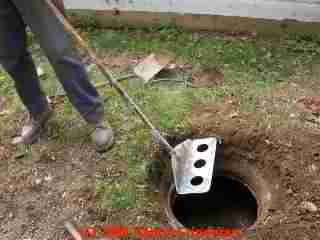 Tools to Measure Septic Tank Scum & Sludge Levels
Tools to Measure Septic Tank Scum & Sludge Levels
Septic Tank Tools
- POST a QUESTION or COMMENT about buying or making a tool to measure the thickness of the septic tank scum layer or sludge layer
Tools for measuring septic tank scum / sludge:
This article explains the necessity of measuring the thickness of the floating scum layer in a septic tank and of measuring the thickness of the settled scum layer in a septic tank as well. We include descriptions of how to make septic sludge and scum measuring tools and how to use them.
Whether your system is a conventional septic tank and drain field, an above ground septic system, or even a holding tank, pumping and inspecting the septic tank is a critical septic tank maintenance and septic system maintenance chore. Septic tank pumping pumping frequency guidance is provided in a table at our website (see links abovet.)
Just before the septic tank is pumped, measurements of the scum layer and sludge layer tell you the condition of the system.
InspectAPedia tolerates no conflicts of interest. We have no relationship with advertisers, products, or services discussed at this website.
- Daniel Friedman, Publisher/Editor/Author - See WHO ARE WE?
USDA / US FPS design for Septic Tank Sludge & Scum Measuring Tube
 Here we describe how to make a simple tube for measuring scum & sludge level in a septic tank. We also describe electronic septic tank scum and sludge level monitoring - a sensor also used for grease traps.
Here we describe how to make a simple tube for measuring scum & sludge level in a septic tank. We also describe electronic septic tank scum and sludge level monitoring - a sensor also used for grease traps.
Why Scum & Sludge Layers Measured Before the Septic Tank is Pumped
These septic tank sludge/scum measurements, made or at least roughly estimated by the septic pumping contractor are made before actually pumping or cleaning the septic septic tank.
The scum layer thickness and sludge layer thickness provide key information that permits the home owner to know:
1) whether or not the septic tank is being pumped often enough, and
2) whether or not there is evidence that the septic fields have been damaged by having not pumped the tank soon enough.
The USDA/FPS sketch above shows a tube and rubber ball design that can be used for measuring both the septic tank floating scum layer, and the septic tank bottom sludge layer thickness.
 The tube can be constructed using acrylic plastic (as shown) or a PVC plastic pipe (more readily available.
The tube can be constructed using acrylic plastic (as shown) or a PVC plastic pipe (more readily available.
All you need is a rubber ball that is a bit larger than the inside diameter of the pipe, some string, a washer, cotter pin or wire, and a scrap of wood for a handle.
The length of pipe needs to be long enough to safely reach the tank bottom without you having to lean over or reach into the tank, but short enough to be easy to handle.
Eight feet should be plenty. If you find that your septic tank bottom is just four or five feet below the ground surface you can later cut some excess off of the pipe.
Shown here is a USDA sketch showing how this measuring tube can easily measure both the floating scum layer in the septic tank and the bottom sludge layer thickness in the tank.
At left is an illustration showing how the pipe and rubber ball measuring system is used to measure septic tank scum layer and bottom sludge layer.
Watch out: opening, leaning over, or falling into a septic tank is dangerous and can be fatal.
Do not work alone. See the safety warnings
at SEPTIC SYSTEM SAFETY WARNINGS.
How to Measure Septic Tank Scum & Sludge Layers
Details of just how to measure the sludge and scum layer thickness are given in this separate article:
MEASURE SEPTIC TANK SCUM & SLUDGE.
A description of normal and abnormal scum and sludge layer thicknesses in the septic tank and an explanation of what abnormal conditions mean is
at SEPTIC TANK LEVELS of SEWAGE.
After the septic tank has been emptied your contractor may examine the interior of the septic tank for signs of trouble.
Our photograph illustrates a simple but effective septic tank inspection tool: an extension pole that sports an adjustable mirror and a bright flashlight.
Details of what to look for when the septic tank has been emptied are found
at INSPECT the SEPTIC TANK AFTER PUMPING
Electronic Monitors for Septic Tank Scum & Sludge Levels
Below at References we also describe an electronic septic tank monitor [photo] or grease trap monitor from Worldstone.
 These devices can track sludge, scum, or grease levels in order to best schedule septic tank pumping or grease trap cleaning. This product is suitable for commercial installations and possibly for some residential septic tank systems.
These devices can track sludge, scum, or grease levels in order to best schedule septic tank pumping or grease trap cleaning. This product is suitable for commercial installations and possibly for some residential septic tank systems.
According to the company, "Data from monitors can help establish appropriate service intervals, and document maintenance for regulatory compliance.
Alarm features can help detect abnormal conditions and prevent costly backups."The company also produces an oil tank level monitor.
Thanks to reader Robert Shirley for this tip.
OPINION - DF: this product is a great idea for commercial installations or problem septic installations. Substituting actual septic tank scum layer thickness or scum level thickness data for the septic tank pumping schedule table above may allow the tank to be opened and pumped less often - saving some money.
Watch out: But don't forget that regular opening and inspection of the septic tank, such as happens when the septic tank is to be pumped out or "cleaned", gives an additional opportunity to check for other septic system problems that could be leading to a costly failure, but that don't directly concern the septic tank sludge or scum layer thickness.
Examples include the discovery of lost or damaged septic tank baffles, septic tanks leaks that allow ground water to flood the septic system, or septic tank leaks out of the tank.
Below at in the form of individual detailed articles are the Steps in Septic Tank Cleaning Procedure in the order that they should be performed
Other Septic Tank Cleaning & Inspection Tools
Above: a septic pumper truck and vacuum hose in use.
Also see PUMPER TRUCKS & VACUUM PUMPS SOURCES / SPECS
Shown below, the septic tank muck rake is used to break up the floating scum or settled sludge layer during a thorough septic tank cleanout.
Details are at PUMPING the SEPTIC TANK
...
Continue reading at PUMPER TRUCK OPERATION PROCEDURE or select a topic from the closely-related articles below, or see the complete ARTICLE INDEX.
Or see these
Recommended Articles
- SEPTIC TANK PUMPING PROCEDURE
- CLEANING SEPTIC TANKS
- WHEN to CLEAN THE SEPTIC TANK
- WHEN NOT TO PUMP A SEPTIC TANK
- FIND the SEPTIC TANK, HOW TO
- HOW TO OPEN a SEPTIC TANK
- INSPECT the SEPTIC TANK BEFORE PUMPING
- SEPTIC TANK INSPECTION PROCEDURE
- SEPTIC TANK LEVELS of SEWAGE
- PUMPER TRUCK OPERATION PROCEDURE
- PUMPING the SEPTIC TANK
- RECORD SEPTIC TANK LOCATION
- SEPTIC PUMPING CONCLUSIONS
- SEPTIC TANK PUMPING SCHEDULE
- SEPTIC TANK SAFETY
Suggested citation for this web page
TOOLS for MEASURING SCUM & SLUDGE at InspectApedia.com - online encyclopedia of building & environmental inspection, testing, diagnosis, repair, & problem prevention advice.
Or see this
INDEX to RELATED ARTICLES: ARTICLE INDEX to SEPTIC SYSTEMS
Or use the SEARCH BOX found below to Ask a Question or Search InspectApedia
Ask a Question or Search InspectApedia
Try the search box just below, or if you prefer, post a question or comment in the Comments box below and we will respond promptly.
Search the InspectApedia website
Note: appearance of your Comment below may be delayed: if your comment contains an image, photograph, web link, or text that looks to the software as if it might be a web link, your posting will appear after it has been approved by a moderator. Apologies for the delay.
Only one image can be added per comment but you can post as many comments, and therefore images, as you like.
You will not receive a notification when a response to your question has been posted.
Please bookmark this page to make it easy for you to check back for our response.
IF above you see "Comment Form is loading comments..." then COMMENT BOX - countable.ca / bawkbox.com IS NOT WORKING.
In any case you are welcome to send an email directly to us at InspectApedia.com at editor@inspectApedia.com
We'll reply to you directly. Please help us help you by noting, in your email, the URL of the InspectApedia page where you wanted to comment.
Citations & References
In addition to any citations in the article above, a full list is available on request.
- New York State Department of Health, APPENDIX 75-A WASTEWATER TREATMENT STANDARDS - INDIVIDUAL HOUSEHOLD SYSTEMS , [PDF] New York State Department of Health, 3 February 2010, retrieved 3/1/2010, original source: https://www.health.ny.gov/regulations/nycrr/title_10/part_75/appendix_75-a.htm
- SEPTIC TANK/SOIL-ABSORPTION SYSTEMS: HOW TO OPERATE & MAINTAIN [PDF] - , Equipment Tips, U.S. Department of Agriculture, 8271 1302, 7100 Engineering, 2300 Recreation, September 1982, web search 08/28/2010, original source: http://www.fs.fed.us/t-d/pubs/pdfimage/82711302.pdf.
- SEPTIC TANK LEVELS of SEWAGE - details on normal and abnormal levels and what they mean.
- Mark Cramer Inspection Services Mark Cramer, Tampa Florida, Mr. Cramer is a past president of ASHI, the American Society of Home Inspectors and is a Florida home inspector and home inspection educator. Mr. Cramer serves on the ASHI Home Inspection Standards. Contact Mark Cramer at: 727-595-4211 mark@BestTampaInspector.com
- John Cranor [Website: /www.house-whisperer.com ] is an ASHI member and a home inspector (The House Whisperer) is located in Glen Allen, VA 23060. He is also a contributor to InspectApedia.com in several technical areas such as plumbing and appliances (dryer vents). Contact Mr. Cranor at 804-873-8534 or by Email: johncranor@verizon.net
- Thanks to Richard at Effluent Services, Ltd., Cambridge 3434 NZ for the suggestions regarding the significance of the septic tank floating scum layer and settled sludge layer. New Zealand readers can contact this septic system service company at 07 827 0436 or Waikato Wide: 0800 EFFLUENT.
- Thanks to reader Robert Shirley, Calgary, for discussing alternative ways to measure septic tank sludge, including the relatively low cost electronic system on the market from Worldstone Inc. (SepticWatch) - a system to monitor sludge and scum and grease levels in grease traps or septic tanks - 04/20/2010
- Mark Cramer Inspection Services Mark Cramer, Tampa Florida, Mr. Cramer is a past president of ASHI, the American Society of Home Inspectors and is a Florida home inspector and home inspection educator. Mr. Cramer serves on the ASHI Home Inspection Standards. Contact Mark Cramer at: 727-595-4211 mark@BestTampaInspector.com
- John Cranor [Website: /www.house-whisperer.com ] is an ASHI member and a home inspector (The House Whisperer) is located in Glen Allen, VA 23060. He is also a contributor to InspectApedia.com in several technical areas such as plumbing and appliances (dryer vents). Contact Mr. Cranor at 804-873-8534 or by Email: johncranor@verizon.net
- Worldstone, http://www.worldstoneinc.com/ electronic monitors, including via internet, for grease traps, septic tanks, oil tanks - manufactured by F.O.G. Solutions,
1348 Delta Drive, Saginaw, MI 48638, 866 279-2824, 989-928-1806, Fax 480-247-4983. The Company also makes an oil tank level monitor.
"Worldstone Inc. is a Braintree Massachusetts based company that specializes in separation tank monitoring. Using established ultrasonic technologies, Worldstone’s GREASEwatch, SEPTICwatch and OILwatch monitors capture critical tank information and transfers data to city officials, end users or service providers creating a safer, cost effective solution to manual inspections. Data from monitors can help establish appropriate service intervals, and document maintenance for regulatory compliance. Alarm features can help detect abnormal conditions and prevent costly backups.
Worldstone monitors are currently assisting over 200 major restaurants, hospitals, prisons, casinos and city officials across the United States."
Septic Tank Monitoring:
"The SEPTICwatch monitor provides continuous monitoring of the sludge, scum, temperature and liquid levels [in a septic tank]. ... real-time information on actual changes as a percentage of permissible floating solids, bottom solids and total solids. It also provides the immediate status of the liquid level within the tank in inches. Using the monitor's programmable Control Unit, the tank's optimum level for pumping is set, so the tank can be pumped when it's actually needed. The [septic tank] monitor's Control Unit can also be programmed to warn of dangerously high solid levels and lower than normal/higher than normal liquid levels - emergency conditions that could indicate system failure."
Grease Trap Monitoring:
"...GREASEwatch monitor uses ultrasonic transducers and an embedded microprocessor to continuously monitor the sludge, scum, liquid levels and temperature in your grease trap. ... get real-time information on incremental changes in the levels of floating solids, bottom solids and total solids at the touch of a button. ... the immediate status of the liquid level in the trap in inches. The Control Unit can be programmed to indicate how full the tank should be before pumping, so there's no more guessing when it's time for service. The GREASEwatch monitor lets you plan a pumping level that meets your needs and protects your investment." - Ten Steps to Keeping a Septic System Working, suggestions from the U.S. EPA, edits and additions by DJF
- Pennsylvania State Wastewater Treatment Fact Sheet SW-161, Septic System Failure: Diagnosis and Treatment
- Pennsylvania State Wastewater Treatment Fact Sheet SW-162, The Soil Media and the Percolation Test
- Pennsylvania State Wastewater Treatment Fact Sheet SW-l64, Mound Systems for Wastewater Treatment
- Pennsylvania State Wastewater Treatment Fact Sheet SW-165, Septic Tank-Soil Absorption Systems
- Document Sources used for this web page include but are not limited to: Agricultural Fact Sheet #SW-161 "Septic Tank Pumping," by Paul D. Robillard and Kelli S. Martin. Penn State College of Agriculture - Cooperative Extension, edited and annotated by Dan Friedman (Thanks: to Bob Mackey for proofreading the original source material.)
- Advanced Onsite Wastewater Systems Technologies, Anish R. Jantrania, Mark A. Gross. Anish Jantrania, Ph.D., P.E., M.B.A., is a Consulting Engineer, in Mechanicsville VA, 804-550-0389 (2006). Outstanding technical reference especially on alternative septic system design alternatives. Written for designers and engineers, this book is not at all easy going for homeowners but is a text I recommend for professionals--DF.
- Our recommended books about building & mechanical systems design, inspection, problem diagnosis, and repair, and about indoor environment and IAQ testing, diagnosis, and cleanup are at the InspectAPedia Bookstore. Also see our Book Reviews - InspectAPedia.
- In addition to citations & references found in this article, see the research citations given at the end of the related articles found at our suggested
CONTINUE READING or RECOMMENDED ARTICLES.
- Carson, Dunlop & Associates Ltd., 120 Carlton Street Suite 407, Toronto ON M5A 4K2. Tel: (416) 964-9415 1-800-268-7070 Email: info@carsondunlop.com. Alan Carson is a past president of ASHI, the American Society of Home Inspectors.
Thanks to Alan Carson and Bob Dunlop, for permission for InspectAPedia to use text excerpts from The HOME REFERENCE BOOK - the Encyclopedia of Homes and to use illustrations from The ILLUSTRATED HOME .
Carson Dunlop Associates provides extensive home inspection education and report writing material. In gratitude we provide links to tsome Carson Dunlop Associates products and services.




